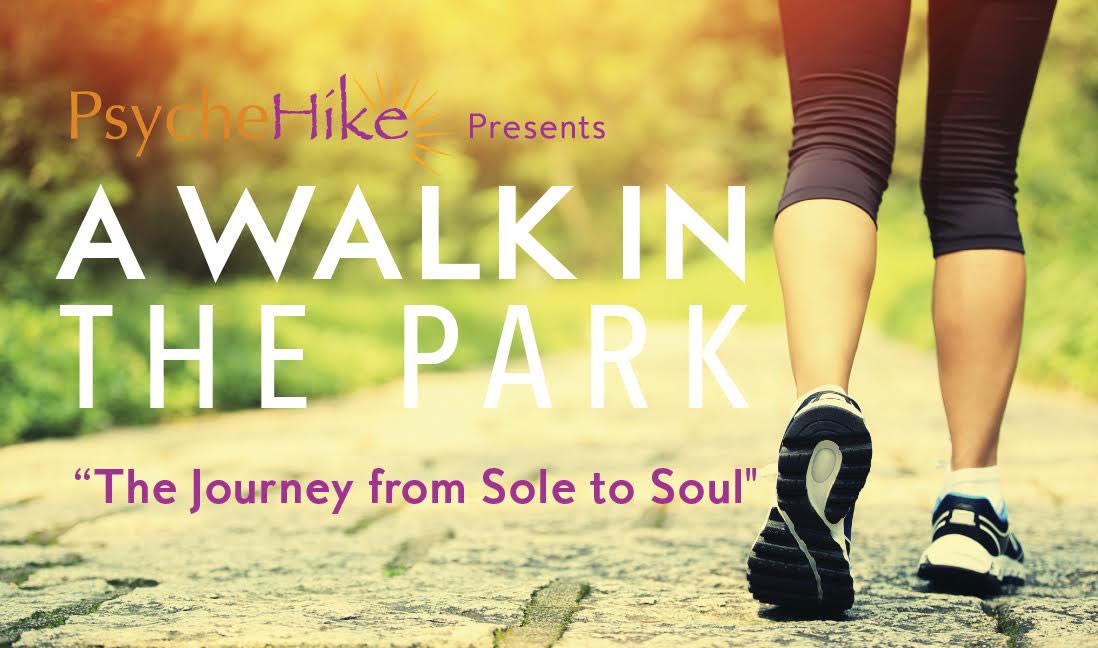From sole to soul with Audrey Boxwell
In our first interview with Audrey Boxwell, a psychotherapist, hypnotherapist, chaplain, pastoral counselor, and nationally recognized expert on the mind’s power to heal body and spirit, she defines the spiritual and practical rituals for healing, including her trademark PsycheHike, a meditative hiking program she founded to reduce stress and foster resilience and team building.
In this interview, she delves deeper into the power of PsycheHike and other techniques to encourage the path of healing.
Q: Tell us about your newest initiative, Walk in the Park. How does it differ from PsycheHike?
A: Walk in the Park is an hour of one-on-one counseling in an outdoor park. Just breathing in the fresh air is amazingly restorative. Movement in itself promotes vulnerability, which, in turn, encourages soulfulness. Also, when you walk alongside your therapist, you’re on equal footing, like walking with a good friend. The informality of this approach leads to open conversation, and it’s within this atmosphere that true healing in both mind and body can more easily take place.
PsycheHike, by comparison, is done with a group of individuals who are working on similar goals. We set our intentions at the onset of the hike, followed by a silent, meditative walk upward—ascending to the summit of a mountain trail. Reaching higher ground acts as a metaphor for getting to the truth of a situation or problem that feels unsolvable.
Q: What led you to develop these active meditation programs?
A: My friend Deb Sandella, PhD, developed a protocol for meditative healing that I used for my doctoral studies (on patients with irritable bowel syndrome). I then took that meditative process and married it with movement. After all, I couldn’t possibly be the only “itchy ass” on the planet! No joke. I’m not very good at sitting still, yet as soon as I took a walk or a hike, I noticed the way my mind slowed and feelings of ease and grace, optimism and joy, came to me—similar to those reported by seasoned meditators. That’s when I realized the meditative state could be obtained by moving as well as sitting.
Q: Any breakthrough moments you can share?
A: Years ago, a woman I’ll refer to as Darlene, participated in a PsycheHike that led to a total emotional and physical transformation. Darlene’s daughter enrolled her on the hike because her mom was depressed from being out of work and having put on considerable weight. “I don’t know why I’m doing this,” Darlene complained. “I know I’m not going to make it, and then I’ll probably feel worse than I do now.” She was on the verge of tears before we’d even begun so I asked her to stop pressuring herself and just enjoy the scenery. “Let go and let God,” I advised, as she rolled her eyes backward in disgust. Well, in spite of Darlene’s agitation, she kept at it, reaching the top. Everyone cheered and clapped her victory. Darlene’s inner dam broke when, after our guided meditation and journaling exercise, she opened up about her complicated feelings of inferiority stemming from her inability to land work.
Just last year Darlene attended another retreat of mine. But I didn’t recognize her at first. She was 50 pounds lighter and now a successful interior designer who exuberated confidence. She looked beautiful, energetic, and happy. I can’t tell you how delighted I was to hear that Darlene has made it a lifetime practice to hike and walk.
Q: What are some other benefits of meditative walking and hiking?
A: Dating back to the fourth century BC, the Greek philosopher Diogenes answered the question, “Is emotion real?” with a two-word response: “Solvitur ambulando.” Translation: it is solved by walking. I love that! Today, there are numerous studies confirming the tangible health benefits of walking, from improved cardiovascular health to increased energy, higher brain functioning and memory, enhanced cognitive performance, and overall feelings of well-being. One study of note by Dutch researchers showed that individuals living and walking in a wooded area suffered lower rates of depression and anxiety than their fellow city dwellers. Henry David Thoreau discovered this phenomenon over a century ago when taking daily walks in the wooded area around his house. He famously said, “Methinks that the moment my legs began to move, my thoughts began to flow.”
Q: How can ESME readers organize their own meditative walks or hikes?
A: I’m delighted to offer readers an introductory PsycheHike outline/workbook at no charge for a limited time. Just email me at DrAudrey@psychehike.net. It’s my greatest wish for readers to avail themselves of the gift of movement in order to gain deeper clarity, life purpose, and better physical and spiritual health.
I also lead customized workshops and retreats for businesses, faith groups, women’s empowerment forums, and wedding parties. Individual sessions are also available through Walk in the Park.
Visit www.audreyboxwell.com or www.psychehike.net, or email me at DrAudrey@psychehike.net to learn more.
Let’s get walking in 2016. There’s no better time to take the journey from sole to soul.
Nancy Sharp is an author, keynote speaker, trainer, and coach who frequently speaks publicly about loss, resilience, and bold living. The author of the award-winning memoir, Both Sides Now: A True Story of Love, Loss, and Bold Living, and the picture book Because the Sky Is Everywhere, Nancy lives in Denver with her second husband, her twins, and her two stepsons. You can find her on Twitter at @BoldLivingNow and Facebook at Nancy Sharp. Learn more at www.NancySharp.net.
Please feel free to contact us with any comments or questions.









